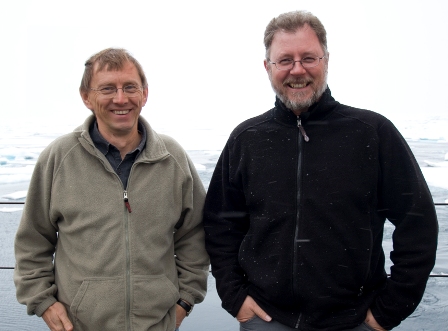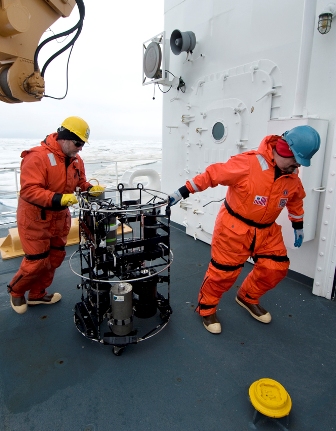From: Kevin Arrigo, Stanford University, with interview by Haley Smith Kingsland, Stanford University

Dariusz Stramski and Rick Reynolds (Photo by Haley Smith Kingsland)
Light. During our waking hours it surrounds us almost constantly, yet we usually give it very little thought. However, our perception of the world surely would be very different without it. ICESCAPE takes light very seriously. That’s because it not only allows us to perceive this spectacular Arctic environment, but also tells us a great deal about that environment.
ICESCAPE has three research groups dedicated to studying light in the ocean, a science usually referred to as “ocean optics.” One of them, led by Rick Reynolds and Dariusz Stramski of the Scripps Institution of Oceanography, is focusing on how light interacts with the myriad shapes and sizes of particles that float beneath the ocean surface. Rick and Dariusz are especially interested in tiny particles that are rarely studied but the most abundant.
Dariusz became interested in optics at a very young age. “I was interested in a very spectacular phenomenon— the optical effects you observe on a sunny day on the shallow bottom of a swimming pool; the mosaic of brightness of light sweeping across the bottom.” He was hooked. Rick’s interest was an offshoot of his graduate studies of how algae absorb light to make sugars during photosynthesis. “I wanted to understand what controls how algae grow, and to do that you have to understand light.” He was also intrigued by the challenges of being an oceanographer— while at sea, one has to be ready for anything. As Rick observed, “You just learn to improvise when you’re out here because there’s not a convenient hardware store anywhere around if something breaks. Take an oceanographer and give him a roll of duct tape and cable ties and he can get you to the moon.” Fortuitously, both scientists found themselves at the University of Southern California in the late 1980’s, where they forged a close collaboration that continues to this day.
Rick and Dariusz use a few different techniques to study how light interacts with particles. In one, they take water samples and put them into a few different state-of-the-art particle counters. However, these instruments don’t just count the particles— they determine their size, and if possible, identify what they are. In the other technique, Rick and Dariusz drop a suite of instruments right into the water and measure how much light is absorbed and scattered at different depths. By comparing these two sets of measurements, they can better understand how particles affect the optics of water, including its color.
Why do this? Because once we understand what gives the ocean its color, we can measure that color and learn a great deal about what is in the ocean. A blue ocean? In addition to the natural color imparted by water molecules themselves, probably lots of little particles that scatter but don’t absorb much light— but not much else. Kind of a desert. A green ocean? Lots of phytoplankton that absorb blue and red light and reflect green. A veritable oasis. A brown ocean? Either lots of colored dissolved matter (like the stuff that makes your tea brown) or floating particles of dirt and mud (when near the coast). We hope that with enough information, we will be able to distinguish these scenarios and tell different phytoplankton groups apart just by measuring the color of the ocean.
Today we measure ocean color from space using satellites. However, as Dariusz notes, “If you want to get some information about the surface ocean from satellites, it’s a very, very difficult, challenging problem. We want to know about seawater constituents—phytoplankton, or other types of things in the water— from light that leaves the ocean and eventually reaches the satellite sensor. The big challenge is that the contributions to that signal, to light that eventually reaches the satellite signal, comes from very many types of things that are suspended in water.” Thus, Dariusz and Rick’s keen interest in the minute details about what kinds of particles are in seawater and what each of them does to light.
Fortunately, ICESCAPE’s slice of the Arctic Ocean has proven to be optically quite variable, providing many different colors of water for the duo to sample. As Rick puts it, “One of the interesting things for me so far on this cruise has been how things change so dramatically in such a short distance.” Yet our intrepid oceanographers remain undaunted about sampling Arctic waters. “It’s an exciting place to work because it’s challenging,” says Rick. Dariusz echoes, “This is a type of profession in which you’re always challenged intellectually and you’re always discovering things— and re-discovering perhaps. Oceanography is really a wonderful profession and I would recommend it to anybody.”
I couldn’t agree more!

From the fantail Rick deploys the IOP, an optical package that includes instruments to measure the backscattering, loss, absorption, and attenuation of light in the water column. (Photo by Haley Smith Kingsland)

Rick and Brian Schieber, also of Scripps, bring the IOP back inside after it’s made its measurements underwater. (Photo by Haley Smith Kingsland)
